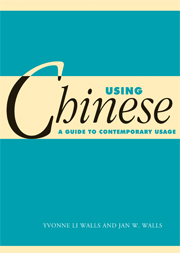1 - Varieties of language and register
Published online by Cambridge University Press: 05 June 2012
Summary
Introduction
It has been several centuries since non-native speakers around the world first began systematically learning the Chinese language. In imperial China, the Jesuit order published Chinese language textbooks for use by their missionaries. Chinese has been widely taught in universities and colleges in the West for many decades now, and the demand for Chinese language instruction has been increasing steadily, to the point where it is now taught in many secondary and even primary schools in Europe and North America. If grammar is considered in the narrower sense of rules for the expression of differences in case, number, person, tense, and voice, then Chinese is said by some to have little or very simplistic grammar. As a result, learning Chinese often has been believed to be a tedious exercise in rote memorization of words and expressions. However, as a human language, Chinese definitely has a well-ordered structure and organization, and therefore has a grammar.
From the learner–user's point of view, Chinese grammar also needs systematic treatment, so that learning can become a more logical and orderly process. Once basic grammar has been mastered in a number of conventional contexts, one must proceed to develop command of a more extensive vocabulary in a variety of different situations and contexts in order to truly master it. It is the intention of Using Chinese to address these and a variety of other issues, with a view towards making the learning of Chinese a more sensible and pleasant experience.
- Type
- Chapter
- Information
- Using ChineseA Guide to Contemporary Usage, pp. 1 - 9Publisher: Cambridge University PressPrint publication year: 2009



